Report: Behavioral and Social Factors Influencing Obesity in the US
VerifiedAdded on 2023/02/01
|11
|3057
|77
Report
AI Summary
This report analyzes the health issue of obesity and overweight among children under 5 in the United States, focusing on a pediatrician's concerns within an ethnically diverse population. It outlines specific intervention steps, including counseling, dietary changes, increased physical activity, and, in some cases, medication or surgery. The report then delves into the behavioral factors, such as energy intake and expenditure, and social factors, like social class, stress, and education levels, that contribute to the issue. A systems approach is used to frame the problem, viewing obesity as an international epidemic with heterogeneous patterns. The report also examines an article on the Cafeteria Power Plus intervention and draws lessons applicable to the interventions discussed earlier, emphasizing the importance of environmental aspects and monitoring children's lifestyles. The report emphasizes the need for interventions at both individual and community levels for effective results.
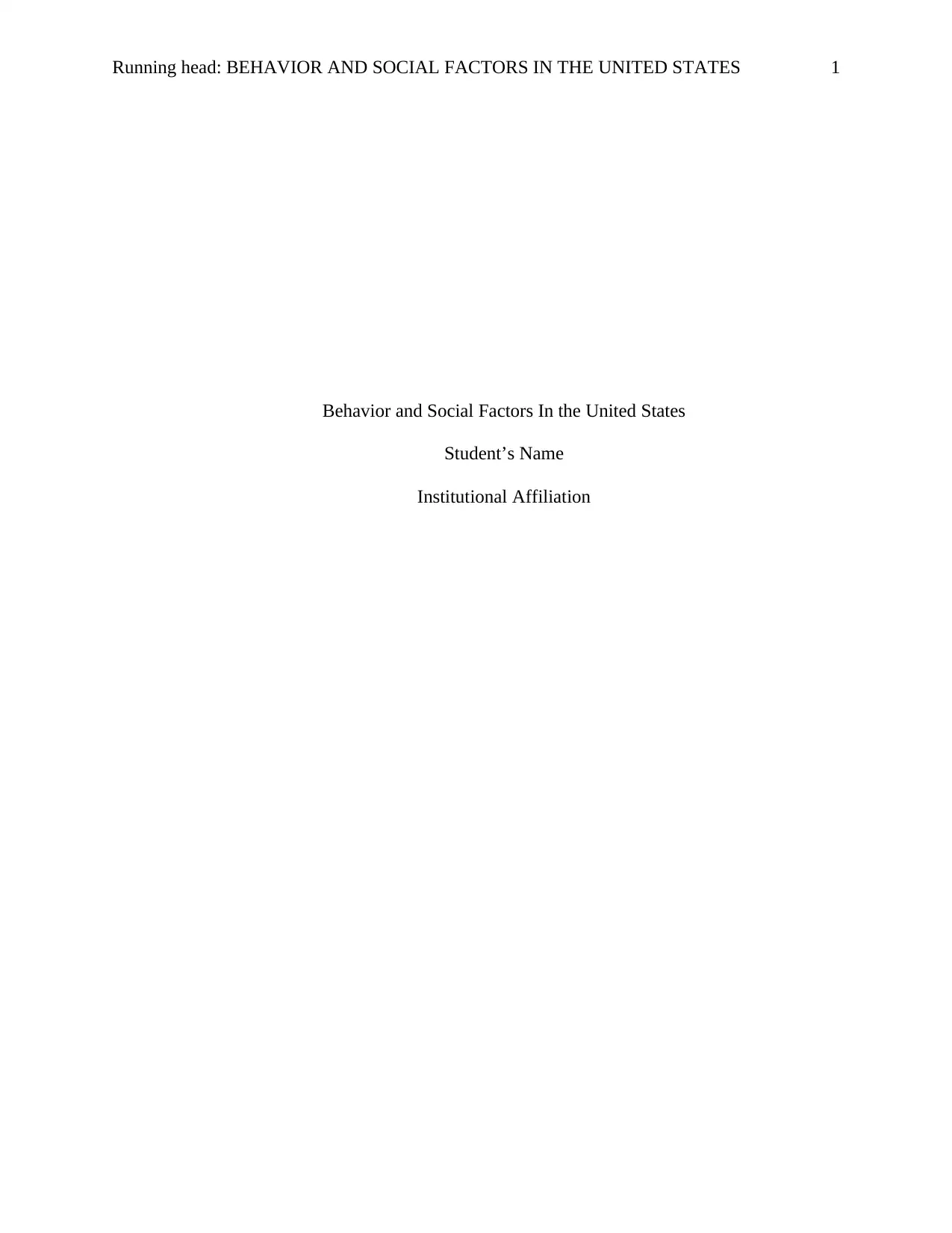
Running head: BEHAVIOR AND SOCIAL FACTORS IN THE UNITED STATES 1
Behavior and Social Factors In the United States
Student’s Name
Institutional Affiliation
Behavior and Social Factors In the United States
Student’s Name
Institutional Affiliation
Paraphrase This Document
Need a fresh take? Get an instant paraphrase of this document with our AI Paraphraser
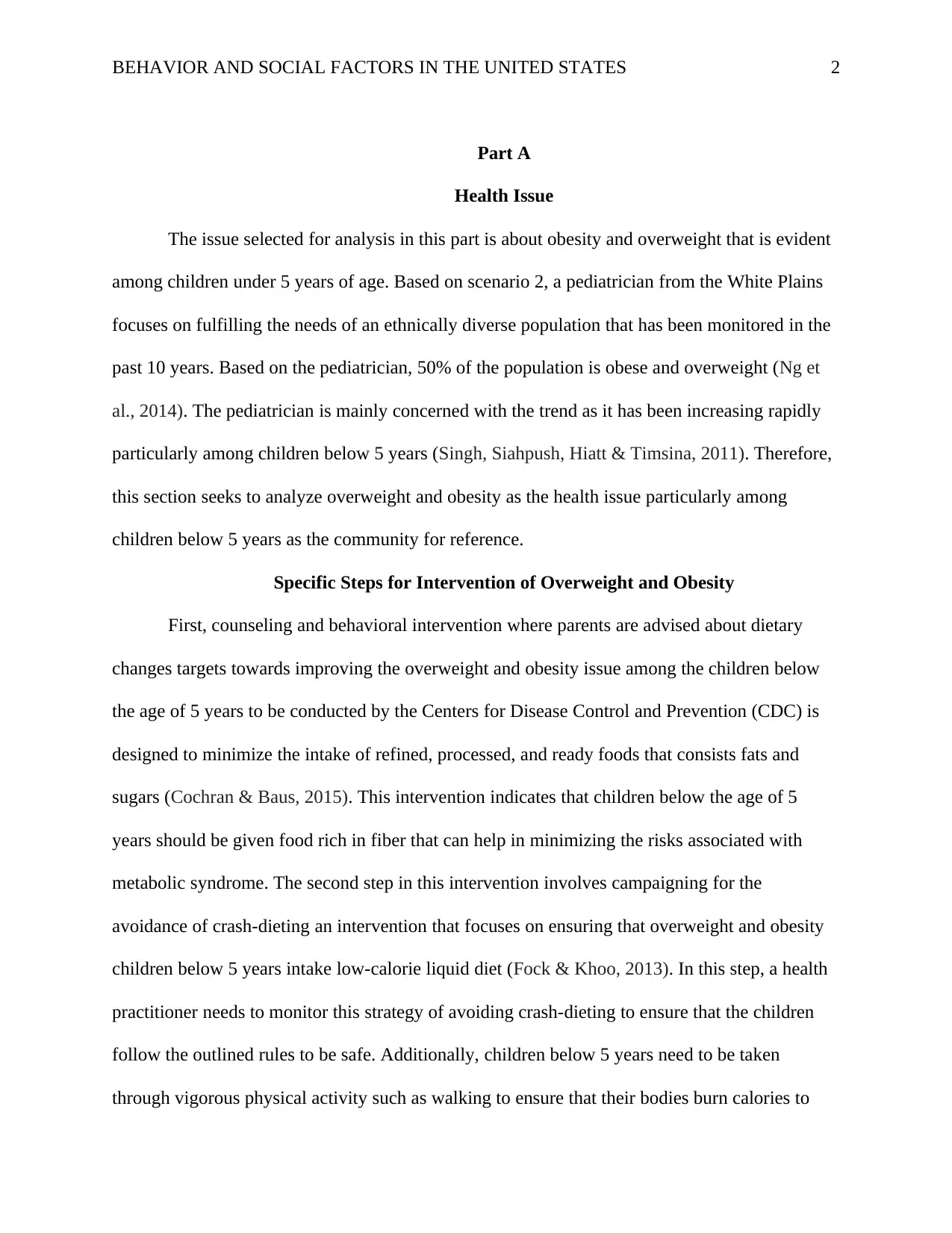
BEHAVIOR AND SOCIAL FACTORS IN THE UNITED STATES 2
Part A
Health Issue
The issue selected for analysis in this part is about obesity and overweight that is evident
among children under 5 years of age. Based on scenario 2, a pediatrician from the White Plains
focuses on fulfilling the needs of an ethnically diverse population that has been monitored in the
past 10 years. Based on the pediatrician, 50% of the population is obese and overweight (Ng et
al., 2014). The pediatrician is mainly concerned with the trend as it has been increasing rapidly
particularly among children below 5 years (Singh, Siahpush, Hiatt & Timsina, 2011). Therefore,
this section seeks to analyze overweight and obesity as the health issue particularly among
children below 5 years as the community for reference.
Specific Steps for Intervention of Overweight and Obesity
First, counseling and behavioral intervention where parents are advised about dietary
changes targets towards improving the overweight and obesity issue among the children below
the age of 5 years to be conducted by the Centers for Disease Control and Prevention (CDC) is
designed to minimize the intake of refined, processed, and ready foods that consists fats and
sugars (Cochran & Baus, 2015). This intervention indicates that children below the age of 5
years should be given food rich in fiber that can help in minimizing the risks associated with
metabolic syndrome. The second step in this intervention involves campaigning for the
avoidance of crash-dieting an intervention that focuses on ensuring that overweight and obesity
children below 5 years intake low-calorie liquid diet (Fock & Khoo, 2013). In this step, a health
practitioner needs to monitor this strategy of avoiding crash-dieting to ensure that the children
follow the outlined rules to be safe. Additionally, children below 5 years need to be taken
through vigorous physical activity such as walking to ensure that their bodies burn calories to
Part A
Health Issue
The issue selected for analysis in this part is about obesity and overweight that is evident
among children under 5 years of age. Based on scenario 2, a pediatrician from the White Plains
focuses on fulfilling the needs of an ethnically diverse population that has been monitored in the
past 10 years. Based on the pediatrician, 50% of the population is obese and overweight (Ng et
al., 2014). The pediatrician is mainly concerned with the trend as it has been increasing rapidly
particularly among children below 5 years (Singh, Siahpush, Hiatt & Timsina, 2011). Therefore,
this section seeks to analyze overweight and obesity as the health issue particularly among
children below 5 years as the community for reference.
Specific Steps for Intervention of Overweight and Obesity
First, counseling and behavioral intervention where parents are advised about dietary
changes targets towards improving the overweight and obesity issue among the children below
the age of 5 years to be conducted by the Centers for Disease Control and Prevention (CDC) is
designed to minimize the intake of refined, processed, and ready foods that consists fats and
sugars (Cochran & Baus, 2015). This intervention indicates that children below the age of 5
years should be given food rich in fiber that can help in minimizing the risks associated with
metabolic syndrome. The second step in this intervention involves campaigning for the
avoidance of crash-dieting an intervention that focuses on ensuring that overweight and obesity
children below 5 years intake low-calorie liquid diet (Fock & Khoo, 2013). In this step, a health
practitioner needs to monitor this strategy of avoiding crash-dieting to ensure that the children
follow the outlined rules to be safe. Additionally, children below 5 years need to be taken
through vigorous physical activity such as walking to ensure that their bodies burn calories to
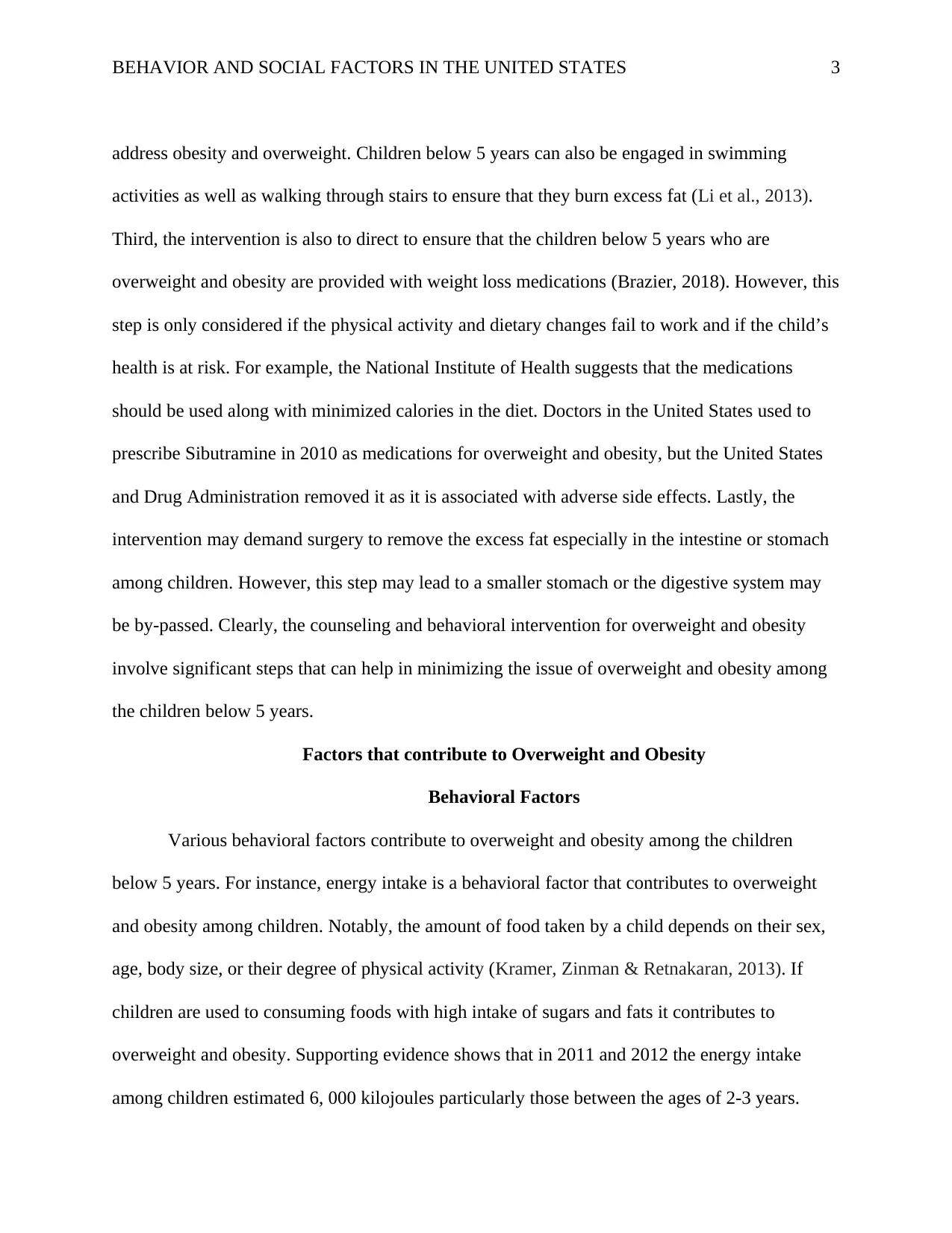
BEHAVIOR AND SOCIAL FACTORS IN THE UNITED STATES 3
address obesity and overweight. Children below 5 years can also be engaged in swimming
activities as well as walking through stairs to ensure that they burn excess fat (Li et al., 2013).
Third, the intervention is also to direct to ensure that the children below 5 years who are
overweight and obesity are provided with weight loss medications (Brazier, 2018). However, this
step is only considered if the physical activity and dietary changes fail to work and if the child’s
health is at risk. For example, the National Institute of Health suggests that the medications
should be used along with minimized calories in the diet. Doctors in the United States used to
prescribe Sibutramine in 2010 as medications for overweight and obesity, but the United States
and Drug Administration removed it as it is associated with adverse side effects. Lastly, the
intervention may demand surgery to remove the excess fat especially in the intestine or stomach
among children. However, this step may lead to a smaller stomach or the digestive system may
be by-passed. Clearly, the counseling and behavioral intervention for overweight and obesity
involve significant steps that can help in minimizing the issue of overweight and obesity among
the children below 5 years.
Factors that contribute to Overweight and Obesity
Behavioral Factors
Various behavioral factors contribute to overweight and obesity among the children
below 5 years. For instance, energy intake is a behavioral factor that contributes to overweight
and obesity among children. Notably, the amount of food taken by a child depends on their sex,
age, body size, or their degree of physical activity (Kramer, Zinman & Retnakaran, 2013). If
children are used to consuming foods with high intake of sugars and fats it contributes to
overweight and obesity. Supporting evidence shows that in 2011 and 2012 the energy intake
among children estimated 6, 000 kilojoules particularly those between the ages of 2-3 years.
address obesity and overweight. Children below 5 years can also be engaged in swimming
activities as well as walking through stairs to ensure that they burn excess fat (Li et al., 2013).
Third, the intervention is also to direct to ensure that the children below 5 years who are
overweight and obesity are provided with weight loss medications (Brazier, 2018). However, this
step is only considered if the physical activity and dietary changes fail to work and if the child’s
health is at risk. For example, the National Institute of Health suggests that the medications
should be used along with minimized calories in the diet. Doctors in the United States used to
prescribe Sibutramine in 2010 as medications for overweight and obesity, but the United States
and Drug Administration removed it as it is associated with adverse side effects. Lastly, the
intervention may demand surgery to remove the excess fat especially in the intestine or stomach
among children. However, this step may lead to a smaller stomach or the digestive system may
be by-passed. Clearly, the counseling and behavioral intervention for overweight and obesity
involve significant steps that can help in minimizing the issue of overweight and obesity among
the children below 5 years.
Factors that contribute to Overweight and Obesity
Behavioral Factors
Various behavioral factors contribute to overweight and obesity among the children
below 5 years. For instance, energy intake is a behavioral factor that contributes to overweight
and obesity among children. Notably, the amount of food taken by a child depends on their sex,
age, body size, or their degree of physical activity (Kramer, Zinman & Retnakaran, 2013). If
children are used to consuming foods with high intake of sugars and fats it contributes to
overweight and obesity. Supporting evidence shows that in 2011 and 2012 the energy intake
among children estimated 6, 000 kilojoules particularly those between the ages of 2-3 years.
⊘ This is a preview!⊘
Do you want full access?
Subscribe today to unlock all pages.

Trusted by 1+ million students worldwide
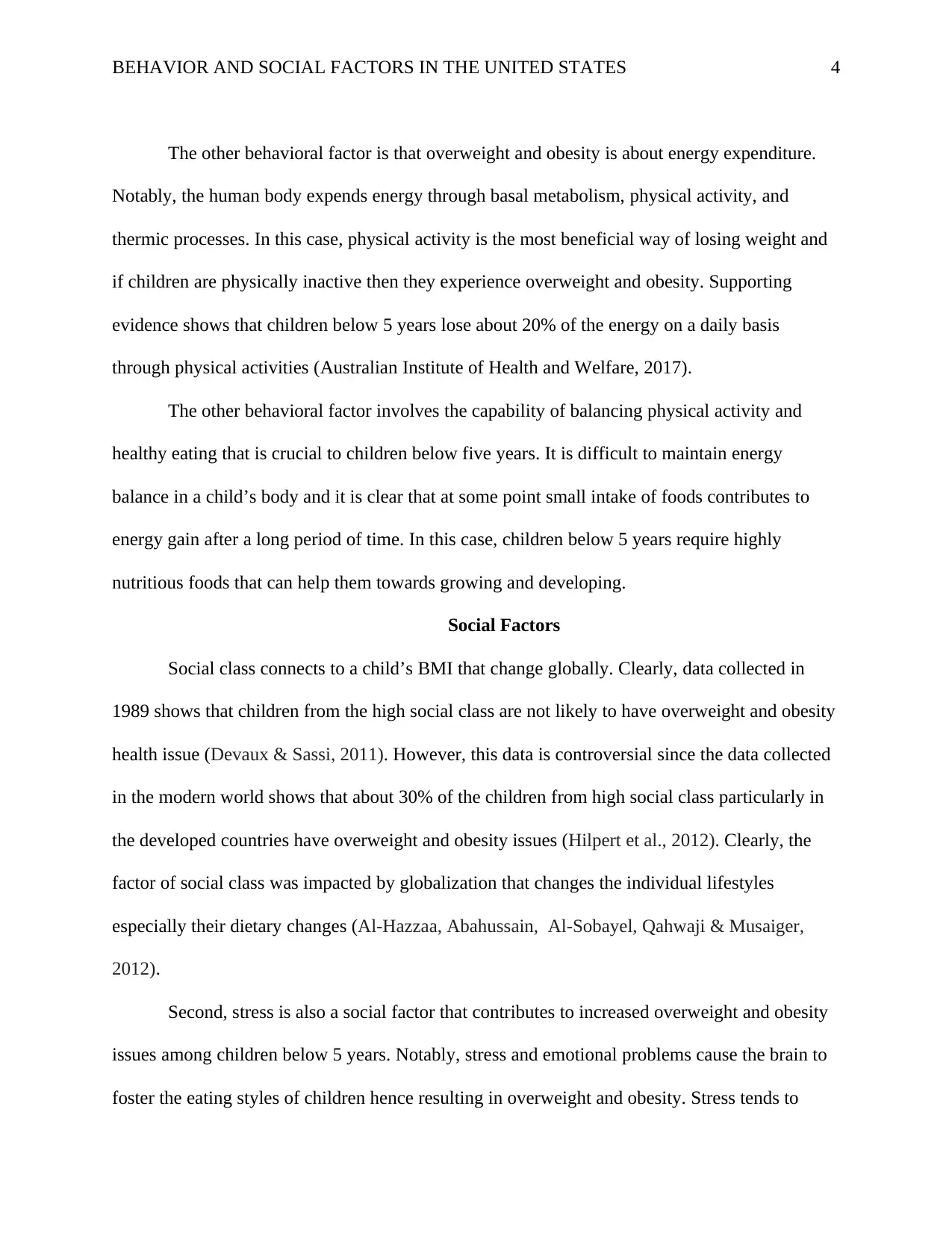
BEHAVIOR AND SOCIAL FACTORS IN THE UNITED STATES 4
The other behavioral factor is that overweight and obesity is about energy expenditure.
Notably, the human body expends energy through basal metabolism, physical activity, and
thermic processes. In this case, physical activity is the most beneficial way of losing weight and
if children are physically inactive then they experience overweight and obesity. Supporting
evidence shows that children below 5 years lose about 20% of the energy on a daily basis
through physical activities (Australian Institute of Health and Welfare, 2017).
The other behavioral factor involves the capability of balancing physical activity and
healthy eating that is crucial to children below five years. It is difficult to maintain energy
balance in a child’s body and it is clear that at some point small intake of foods contributes to
energy gain after a long period of time. In this case, children below 5 years require highly
nutritious foods that can help them towards growing and developing.
Social Factors
Social class connects to a child’s BMI that change globally. Clearly, data collected in
1989 shows that children from the high social class are not likely to have overweight and obesity
health issue (Devaux & Sassi, 2011). However, this data is controversial since the data collected
in the modern world shows that about 30% of the children from high social class particularly in
the developed countries have overweight and obesity issues (Hilpert et al., 2012). Clearly, the
factor of social class was impacted by globalization that changes the individual lifestyles
especially their dietary changes (Al-Hazzaa, Abahussain, Al-Sobayel, Qahwaji & Musaiger,
2012).
Second, stress is also a social factor that contributes to increased overweight and obesity
issues among children below 5 years. Notably, stress and emotional problems cause the brain to
foster the eating styles of children hence resulting in overweight and obesity. Stress tends to
The other behavioral factor is that overweight and obesity is about energy expenditure.
Notably, the human body expends energy through basal metabolism, physical activity, and
thermic processes. In this case, physical activity is the most beneficial way of losing weight and
if children are physically inactive then they experience overweight and obesity. Supporting
evidence shows that children below 5 years lose about 20% of the energy on a daily basis
through physical activities (Australian Institute of Health and Welfare, 2017).
The other behavioral factor involves the capability of balancing physical activity and
healthy eating that is crucial to children below five years. It is difficult to maintain energy
balance in a child’s body and it is clear that at some point small intake of foods contributes to
energy gain after a long period of time. In this case, children below 5 years require highly
nutritious foods that can help them towards growing and developing.
Social Factors
Social class connects to a child’s BMI that change globally. Clearly, data collected in
1989 shows that children from the high social class are not likely to have overweight and obesity
health issue (Devaux & Sassi, 2011). However, this data is controversial since the data collected
in the modern world shows that about 30% of the children from high social class particularly in
the developed countries have overweight and obesity issues (Hilpert et al., 2012). Clearly, the
factor of social class was impacted by globalization that changes the individual lifestyles
especially their dietary changes (Al-Hazzaa, Abahussain, Al-Sobayel, Qahwaji & Musaiger,
2012).
Second, stress is also a social factor that contributes to increased overweight and obesity
issues among children below 5 years. Notably, stress and emotional problems cause the brain to
foster the eating styles of children hence resulting in overweight and obesity. Stress tends to
Paraphrase This Document
Need a fresh take? Get an instant paraphrase of this document with our AI Paraphraser
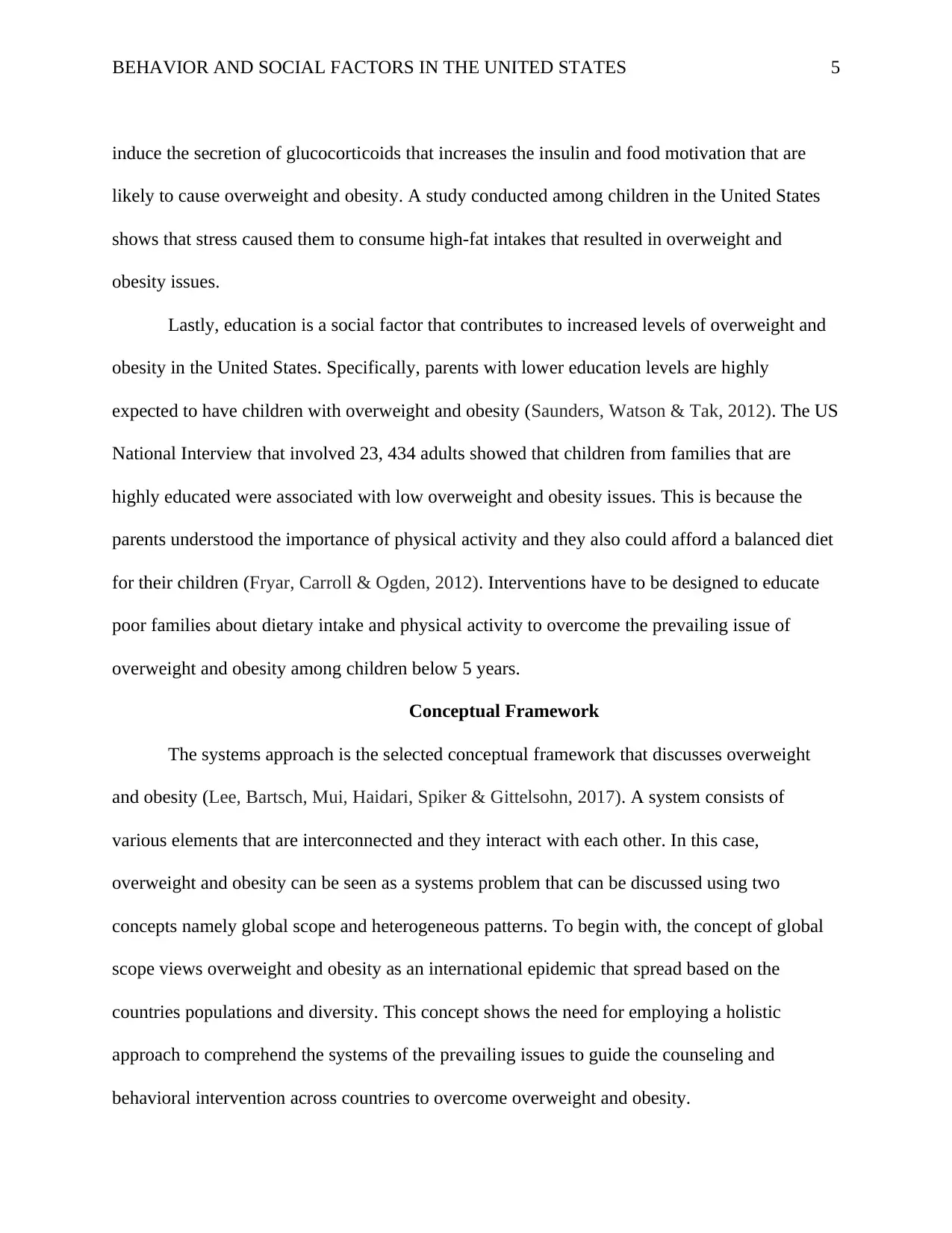
BEHAVIOR AND SOCIAL FACTORS IN THE UNITED STATES 5
induce the secretion of glucocorticoids that increases the insulin and food motivation that are
likely to cause overweight and obesity. A study conducted among children in the United States
shows that stress caused them to consume high-fat intakes that resulted in overweight and
obesity issues.
Lastly, education is a social factor that contributes to increased levels of overweight and
obesity in the United States. Specifically, parents with lower education levels are highly
expected to have children with overweight and obesity (Saunders, Watson & Tak, 2012). The US
National Interview that involved 23, 434 adults showed that children from families that are
highly educated were associated with low overweight and obesity issues. This is because the
parents understood the importance of physical activity and they also could afford a balanced diet
for their children (Fryar, Carroll & Ogden, 2012). Interventions have to be designed to educate
poor families about dietary intake and physical activity to overcome the prevailing issue of
overweight and obesity among children below 5 years.
Conceptual Framework
The systems approach is the selected conceptual framework that discusses overweight
and obesity (Lee, Bartsch, Mui, Haidari, Spiker & Gittelsohn, 2017). A system consists of
various elements that are interconnected and they interact with each other. In this case,
overweight and obesity can be seen as a systems problem that can be discussed using two
concepts namely global scope and heterogeneous patterns. To begin with, the concept of global
scope views overweight and obesity as an international epidemic that spread based on the
countries populations and diversity. This concept shows the need for employing a holistic
approach to comprehend the systems of the prevailing issues to guide the counseling and
behavioral intervention across countries to overcome overweight and obesity.
induce the secretion of glucocorticoids that increases the insulin and food motivation that are
likely to cause overweight and obesity. A study conducted among children in the United States
shows that stress caused them to consume high-fat intakes that resulted in overweight and
obesity issues.
Lastly, education is a social factor that contributes to increased levels of overweight and
obesity in the United States. Specifically, parents with lower education levels are highly
expected to have children with overweight and obesity (Saunders, Watson & Tak, 2012). The US
National Interview that involved 23, 434 adults showed that children from families that are
highly educated were associated with low overweight and obesity issues. This is because the
parents understood the importance of physical activity and they also could afford a balanced diet
for their children (Fryar, Carroll & Ogden, 2012). Interventions have to be designed to educate
poor families about dietary intake and physical activity to overcome the prevailing issue of
overweight and obesity among children below 5 years.
Conceptual Framework
The systems approach is the selected conceptual framework that discusses overweight
and obesity (Lee, Bartsch, Mui, Haidari, Spiker & Gittelsohn, 2017). A system consists of
various elements that are interconnected and they interact with each other. In this case,
overweight and obesity can be seen as a systems problem that can be discussed using two
concepts namely global scope and heterogeneous patterns. To begin with, the concept of global
scope views overweight and obesity as an international epidemic that spread based on the
countries populations and diversity. This concept shows the need for employing a holistic
approach to comprehend the systems of the prevailing issues to guide the counseling and
behavioral intervention across countries to overcome overweight and obesity.
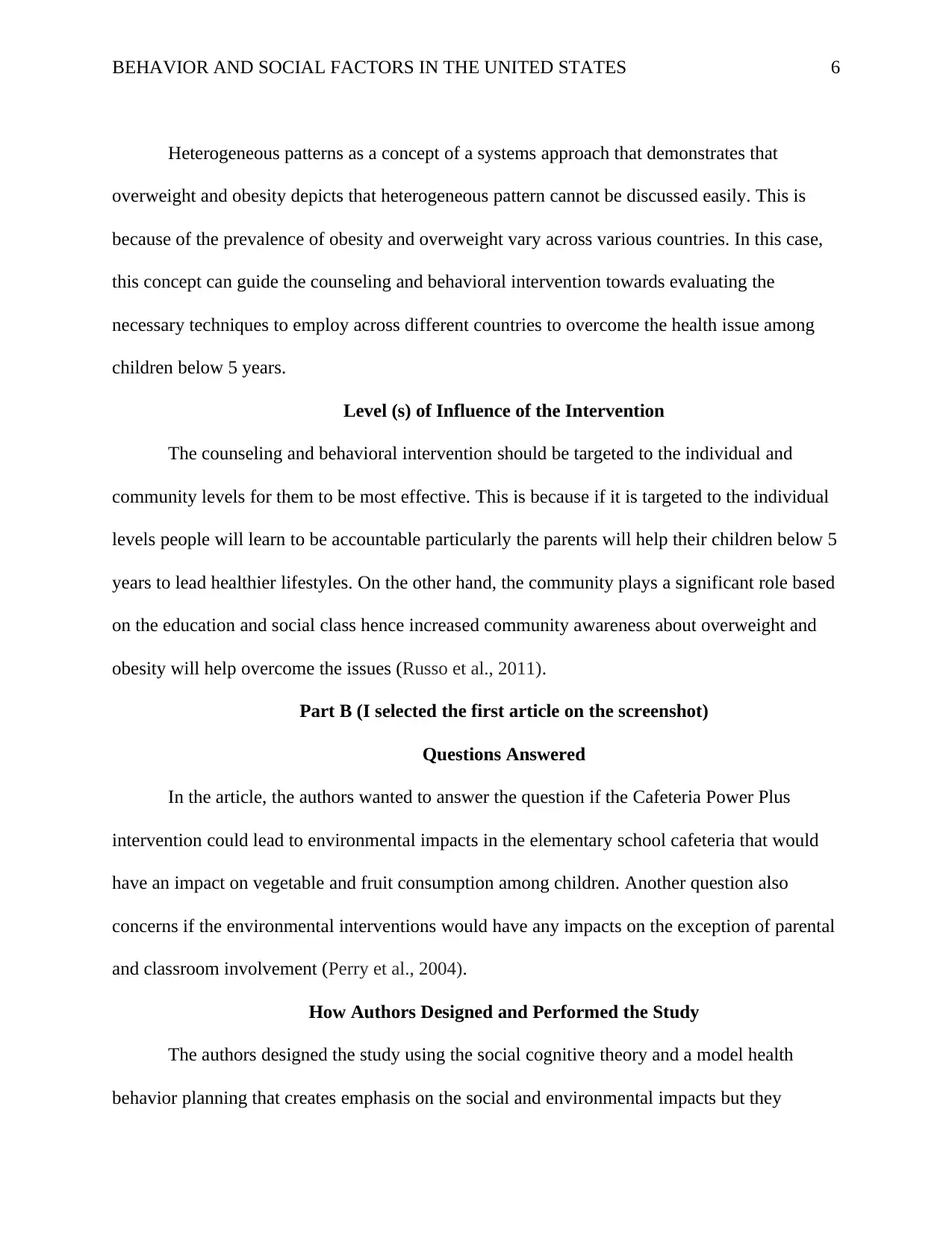
BEHAVIOR AND SOCIAL FACTORS IN THE UNITED STATES 6
Heterogeneous patterns as a concept of a systems approach that demonstrates that
overweight and obesity depicts that heterogeneous pattern cannot be discussed easily. This is
because of the prevalence of obesity and overweight vary across various countries. In this case,
this concept can guide the counseling and behavioral intervention towards evaluating the
necessary techniques to employ across different countries to overcome the health issue among
children below 5 years.
Level (s) of Influence of the Intervention
The counseling and behavioral intervention should be targeted to the individual and
community levels for them to be most effective. This is because if it is targeted to the individual
levels people will learn to be accountable particularly the parents will help their children below 5
years to lead healthier lifestyles. On the other hand, the community plays a significant role based
on the education and social class hence increased community awareness about overweight and
obesity will help overcome the issues (Russo et al., 2011).
Part B (I selected the first article on the screenshot)
Questions Answered
In the article, the authors wanted to answer the question if the Cafeteria Power Plus
intervention could lead to environmental impacts in the elementary school cafeteria that would
have an impact on vegetable and fruit consumption among children. Another question also
concerns if the environmental interventions would have any impacts on the exception of parental
and classroom involvement (Perry et al., 2004).
How Authors Designed and Performed the Study
The authors designed the study using the social cognitive theory and a model health
behavior planning that creates emphasis on the social and environmental impacts but they
Heterogeneous patterns as a concept of a systems approach that demonstrates that
overweight and obesity depicts that heterogeneous pattern cannot be discussed easily. This is
because of the prevalence of obesity and overweight vary across various countries. In this case,
this concept can guide the counseling and behavioral intervention towards evaluating the
necessary techniques to employ across different countries to overcome the health issue among
children below 5 years.
Level (s) of Influence of the Intervention
The counseling and behavioral intervention should be targeted to the individual and
community levels for them to be most effective. This is because if it is targeted to the individual
levels people will learn to be accountable particularly the parents will help their children below 5
years to lead healthier lifestyles. On the other hand, the community plays a significant role based
on the education and social class hence increased community awareness about overweight and
obesity will help overcome the issues (Russo et al., 2011).
Part B (I selected the first article on the screenshot)
Questions Answered
In the article, the authors wanted to answer the question if the Cafeteria Power Plus
intervention could lead to environmental impacts in the elementary school cafeteria that would
have an impact on vegetable and fruit consumption among children. Another question also
concerns if the environmental interventions would have any impacts on the exception of parental
and classroom involvement (Perry et al., 2004).
How Authors Designed and Performed the Study
The authors designed the study using the social cognitive theory and a model health
behavior planning that creates emphasis on the social and environmental impacts but they
⊘ This is a preview!⊘
Do you want full access?
Subscribe today to unlock all pages.

Trusted by 1+ million students worldwide
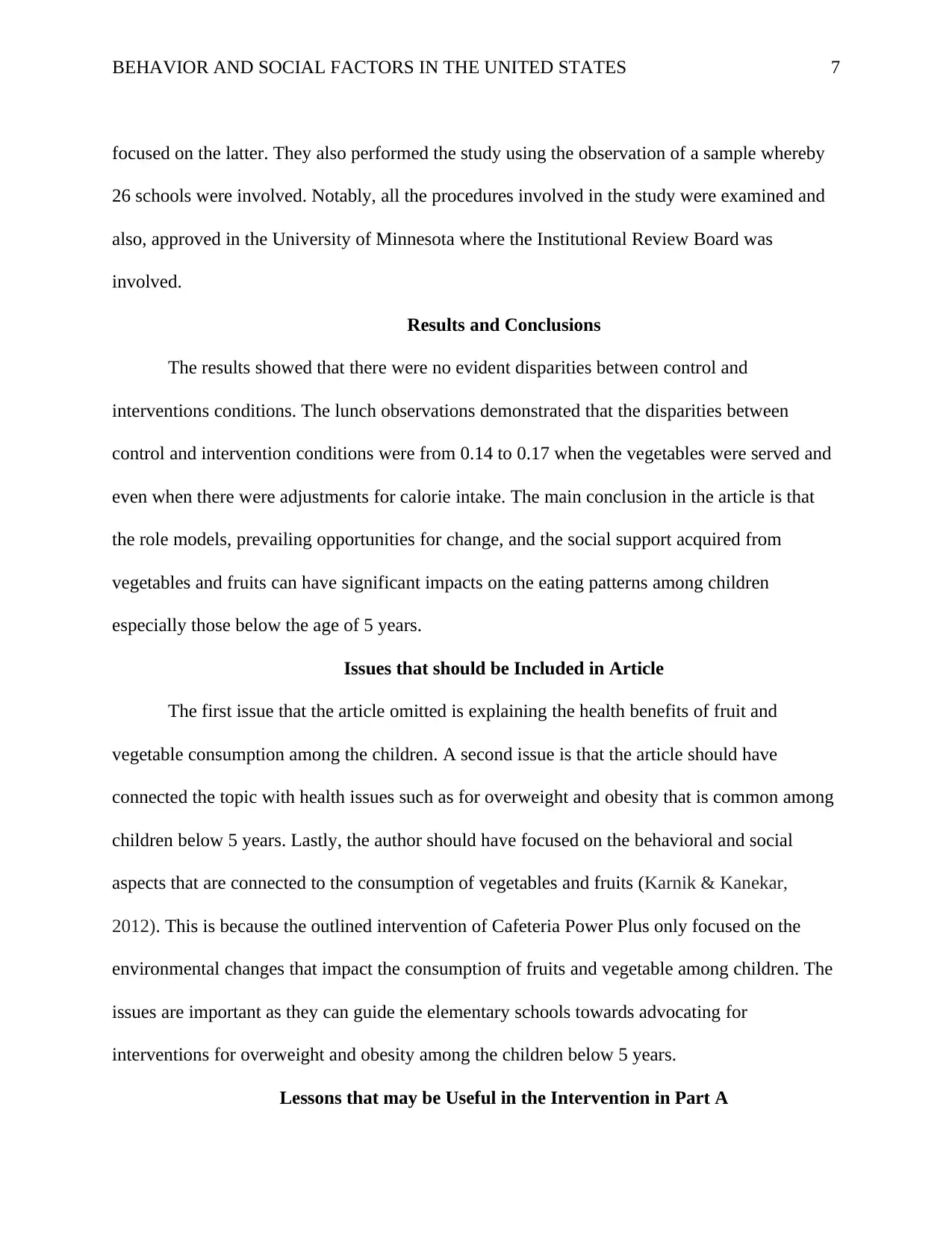
BEHAVIOR AND SOCIAL FACTORS IN THE UNITED STATES 7
focused on the latter. They also performed the study using the observation of a sample whereby
26 schools were involved. Notably, all the procedures involved in the study were examined and
also, approved in the University of Minnesota where the Institutional Review Board was
involved.
Results and Conclusions
The results showed that there were no evident disparities between control and
interventions conditions. The lunch observations demonstrated that the disparities between
control and intervention conditions were from 0.14 to 0.17 when the vegetables were served and
even when there were adjustments for calorie intake. The main conclusion in the article is that
the role models, prevailing opportunities for change, and the social support acquired from
vegetables and fruits can have significant impacts on the eating patterns among children
especially those below the age of 5 years.
Issues that should be Included in Article
The first issue that the article omitted is explaining the health benefits of fruit and
vegetable consumption among the children. A second issue is that the article should have
connected the topic with health issues such as for overweight and obesity that is common among
children below 5 years. Lastly, the author should have focused on the behavioral and social
aspects that are connected to the consumption of vegetables and fruits (Karnik & Kanekar,
2012). This is because the outlined intervention of Cafeteria Power Plus only focused on the
environmental changes that impact the consumption of fruits and vegetable among children. The
issues are important as they can guide the elementary schools towards advocating for
interventions for overweight and obesity among the children below 5 years.
Lessons that may be Useful in the Intervention in Part A
focused on the latter. They also performed the study using the observation of a sample whereby
26 schools were involved. Notably, all the procedures involved in the study were examined and
also, approved in the University of Minnesota where the Institutional Review Board was
involved.
Results and Conclusions
The results showed that there were no evident disparities between control and
interventions conditions. The lunch observations demonstrated that the disparities between
control and intervention conditions were from 0.14 to 0.17 when the vegetables were served and
even when there were adjustments for calorie intake. The main conclusion in the article is that
the role models, prevailing opportunities for change, and the social support acquired from
vegetables and fruits can have significant impacts on the eating patterns among children
especially those below the age of 5 years.
Issues that should be Included in Article
The first issue that the article omitted is explaining the health benefits of fruit and
vegetable consumption among the children. A second issue is that the article should have
connected the topic with health issues such as for overweight and obesity that is common among
children below 5 years. Lastly, the author should have focused on the behavioral and social
aspects that are connected to the consumption of vegetables and fruits (Karnik & Kanekar,
2012). This is because the outlined intervention of Cafeteria Power Plus only focused on the
environmental changes that impact the consumption of fruits and vegetable among children. The
issues are important as they can guide the elementary schools towards advocating for
interventions for overweight and obesity among the children below 5 years.
Lessons that may be Useful in the Intervention in Part A
Paraphrase This Document
Need a fresh take? Get an instant paraphrase of this document with our AI Paraphraser
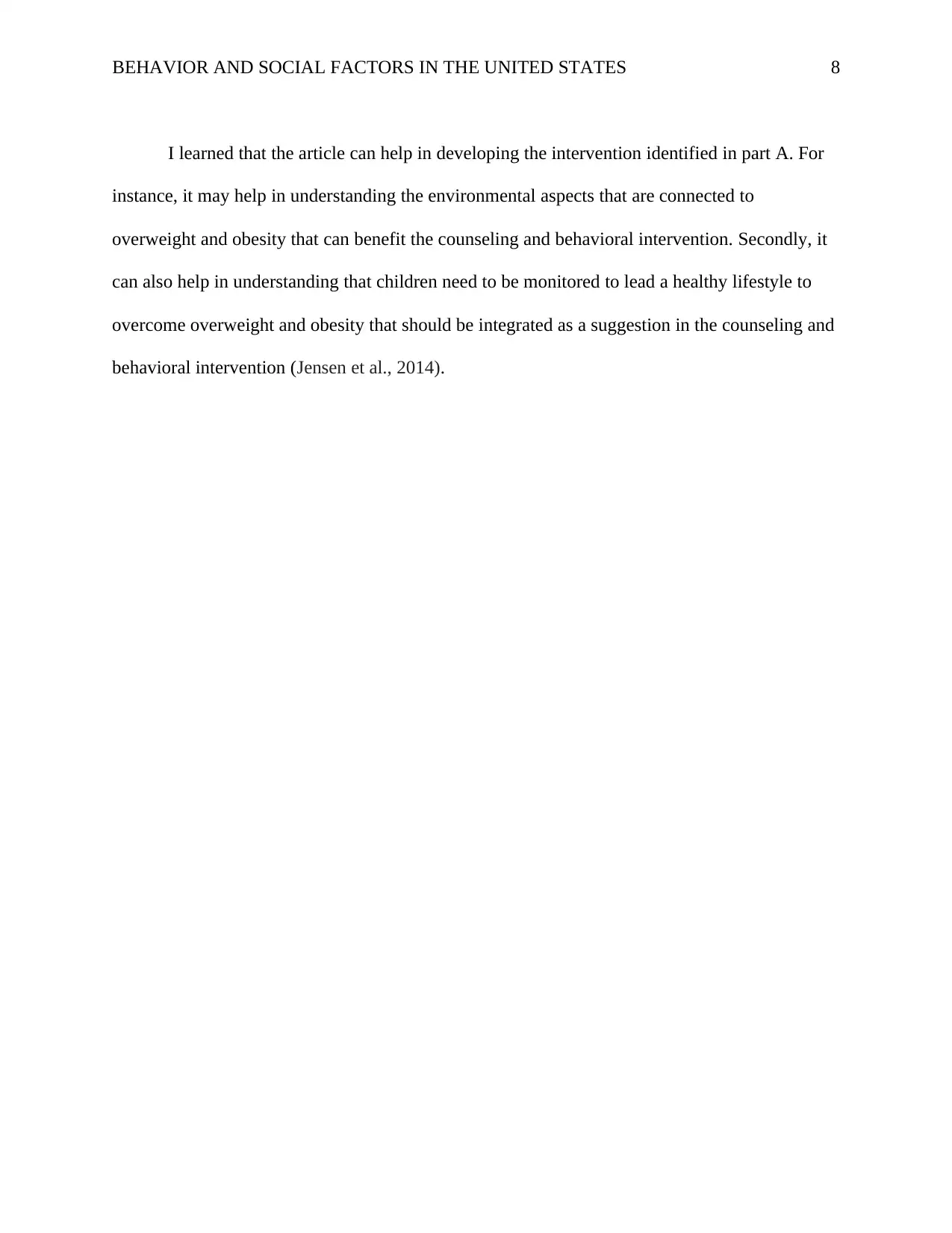
BEHAVIOR AND SOCIAL FACTORS IN THE UNITED STATES 8
I learned that the article can help in developing the intervention identified in part A. For
instance, it may help in understanding the environmental aspects that are connected to
overweight and obesity that can benefit the counseling and behavioral intervention. Secondly, it
can also help in understanding that children need to be monitored to lead a healthy lifestyle to
overcome overweight and obesity that should be integrated as a suggestion in the counseling and
behavioral intervention (Jensen et al., 2014).
I learned that the article can help in developing the intervention identified in part A. For
instance, it may help in understanding the environmental aspects that are connected to
overweight and obesity that can benefit the counseling and behavioral intervention. Secondly, it
can also help in understanding that children need to be monitored to lead a healthy lifestyle to
overcome overweight and obesity that should be integrated as a suggestion in the counseling and
behavioral intervention (Jensen et al., 2014).
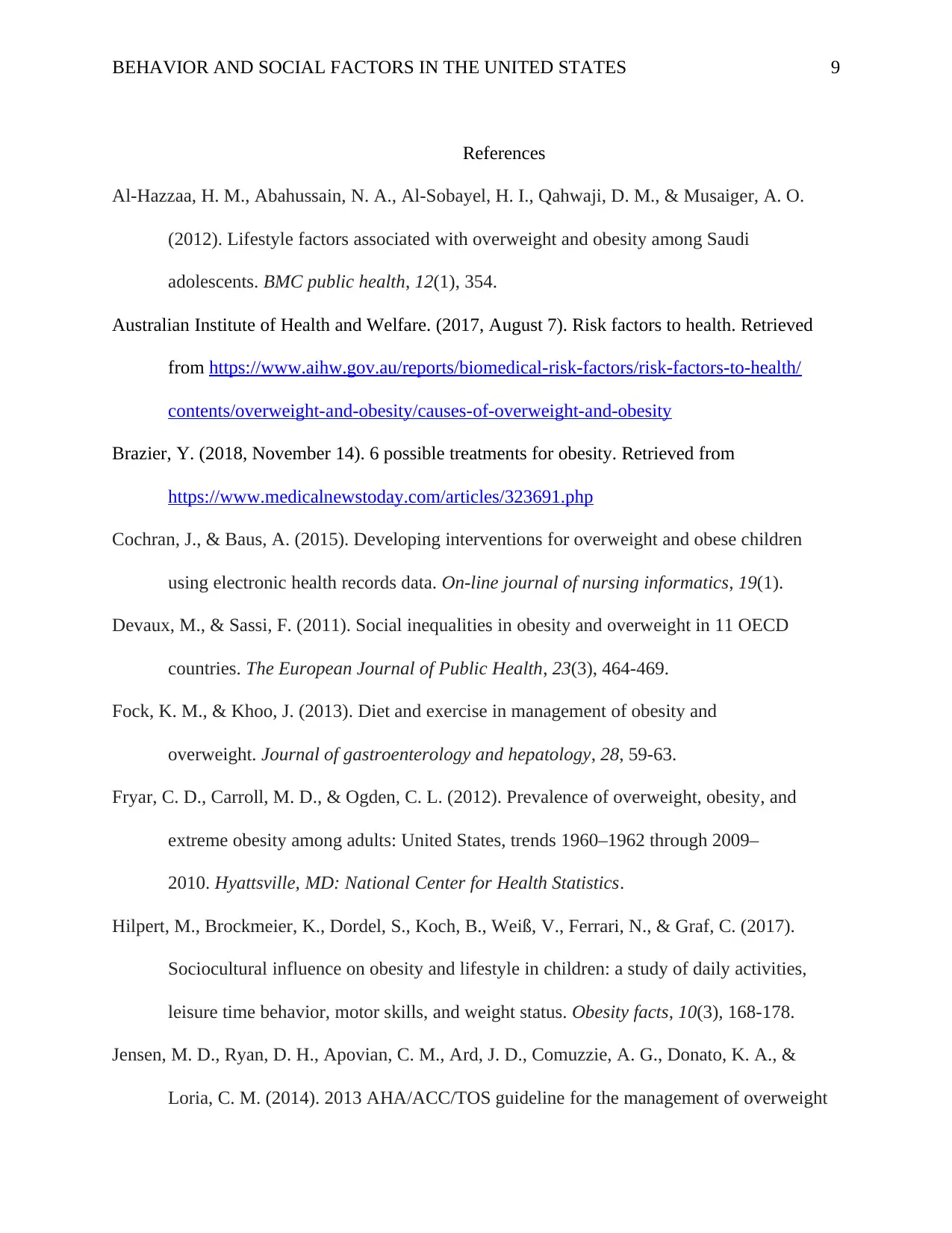
BEHAVIOR AND SOCIAL FACTORS IN THE UNITED STATES 9
References
Al-Hazzaa, H. M., Abahussain, N. A., Al-Sobayel, H. I., Qahwaji, D. M., & Musaiger, A. O.
(2012). Lifestyle factors associated with overweight and obesity among Saudi
adolescents. BMC public health, 12(1), 354.
Australian Institute of Health and Welfare. (2017, August 7). Risk factors to health. Retrieved
from https://www.aihw.gov.au/reports/biomedical-risk-factors/risk-factors-to-health/
contents/overweight-and-obesity/causes-of-overweight-and-obesity
Brazier, Y. (2018, November 14). 6 possible treatments for obesity. Retrieved from
https://www.medicalnewstoday.com/articles/323691.php
Cochran, J., & Baus, A. (2015). Developing interventions for overweight and obese children
using electronic health records data. On-line journal of nursing informatics, 19(1).
Devaux, M., & Sassi, F. (2011). Social inequalities in obesity and overweight in 11 OECD
countries. The European Journal of Public Health, 23(3), 464-469.
Fock, K. M., & Khoo, J. (2013). Diet and exercise in management of obesity and
overweight. Journal of gastroenterology and hepatology, 28, 59-63.
Fryar, C. D., Carroll, M. D., & Ogden, C. L. (2012). Prevalence of overweight, obesity, and
extreme obesity among adults: United States, trends 1960–1962 through 2009–
2010. Hyattsville, MD: National Center for Health Statistics.
Hilpert, M., Brockmeier, K., Dordel, S., Koch, B., Weiß, V., Ferrari, N., & Graf, C. (2017).
Sociocultural influence on obesity and lifestyle in children: a study of daily activities,
leisure time behavior, motor skills, and weight status. Obesity facts, 10(3), 168-178.
Jensen, M. D., Ryan, D. H., Apovian, C. M., Ard, J. D., Comuzzie, A. G., Donato, K. A., &
Loria, C. M. (2014). 2013 AHA/ACC/TOS guideline for the management of overweight
References
Al-Hazzaa, H. M., Abahussain, N. A., Al-Sobayel, H. I., Qahwaji, D. M., & Musaiger, A. O.
(2012). Lifestyle factors associated with overweight and obesity among Saudi
adolescents. BMC public health, 12(1), 354.
Australian Institute of Health and Welfare. (2017, August 7). Risk factors to health. Retrieved
from https://www.aihw.gov.au/reports/biomedical-risk-factors/risk-factors-to-health/
contents/overweight-and-obesity/causes-of-overweight-and-obesity
Brazier, Y. (2018, November 14). 6 possible treatments for obesity. Retrieved from
https://www.medicalnewstoday.com/articles/323691.php
Cochran, J., & Baus, A. (2015). Developing interventions for overweight and obese children
using electronic health records data. On-line journal of nursing informatics, 19(1).
Devaux, M., & Sassi, F. (2011). Social inequalities in obesity and overweight in 11 OECD
countries. The European Journal of Public Health, 23(3), 464-469.
Fock, K. M., & Khoo, J. (2013). Diet and exercise in management of obesity and
overweight. Journal of gastroenterology and hepatology, 28, 59-63.
Fryar, C. D., Carroll, M. D., & Ogden, C. L. (2012). Prevalence of overweight, obesity, and
extreme obesity among adults: United States, trends 1960–1962 through 2009–
2010. Hyattsville, MD: National Center for Health Statistics.
Hilpert, M., Brockmeier, K., Dordel, S., Koch, B., Weiß, V., Ferrari, N., & Graf, C. (2017).
Sociocultural influence on obesity and lifestyle in children: a study of daily activities,
leisure time behavior, motor skills, and weight status. Obesity facts, 10(3), 168-178.
Jensen, M. D., Ryan, D. H., Apovian, C. M., Ard, J. D., Comuzzie, A. G., Donato, K. A., &
Loria, C. M. (2014). 2013 AHA/ACC/TOS guideline for the management of overweight
⊘ This is a preview!⊘
Do you want full access?
Subscribe today to unlock all pages.

Trusted by 1+ million students worldwide
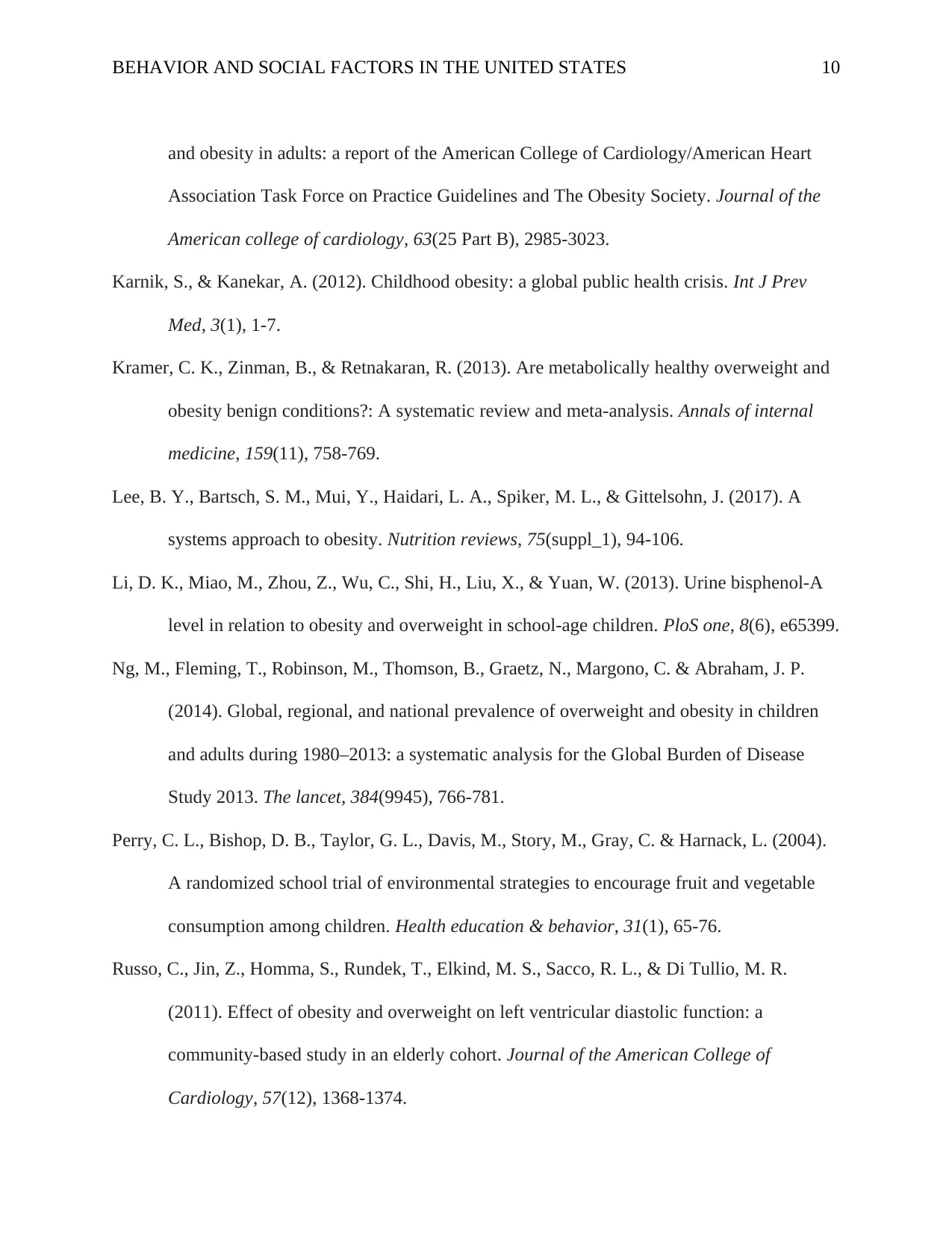
BEHAVIOR AND SOCIAL FACTORS IN THE UNITED STATES 10
and obesity in adults: a report of the American College of Cardiology/American Heart
Association Task Force on Practice Guidelines and The Obesity Society. Journal of the
American college of cardiology, 63(25 Part B), 2985-3023.
Karnik, S., & Kanekar, A. (2012). Childhood obesity: a global public health crisis. Int J Prev
Med, 3(1), 1-7.
Kramer, C. K., Zinman, B., & Retnakaran, R. (2013). Are metabolically healthy overweight and
obesity benign conditions?: A systematic review and meta-analysis. Annals of internal
medicine, 159(11), 758-769.
Lee, B. Y., Bartsch, S. M., Mui, Y., Haidari, L. A., Spiker, M. L., & Gittelsohn, J. (2017). A
systems approach to obesity. Nutrition reviews, 75(suppl_1), 94-106.
Li, D. K., Miao, M., Zhou, Z., Wu, C., Shi, H., Liu, X., & Yuan, W. (2013). Urine bisphenol-A
level in relation to obesity and overweight in school-age children. PloS one, 8(6), e65399.
Ng, M., Fleming, T., Robinson, M., Thomson, B., Graetz, N., Margono, C. & Abraham, J. P.
(2014). Global, regional, and national prevalence of overweight and obesity in children
and adults during 1980–2013: a systematic analysis for the Global Burden of Disease
Study 2013. The lancet, 384(9945), 766-781.
Perry, C. L., Bishop, D. B., Taylor, G. L., Davis, M., Story, M., Gray, C. & Harnack, L. (2004).
A randomized school trial of environmental strategies to encourage fruit and vegetable
consumption among children. Health education & behavior, 31(1), 65-76.
Russo, C., Jin, Z., Homma, S., Rundek, T., Elkind, M. S., Sacco, R. L., & Di Tullio, M. R.
(2011). Effect of obesity and overweight on left ventricular diastolic function: a
community-based study in an elderly cohort. Journal of the American College of
Cardiology, 57(12), 1368-1374.
and obesity in adults: a report of the American College of Cardiology/American Heart
Association Task Force on Practice Guidelines and The Obesity Society. Journal of the
American college of cardiology, 63(25 Part B), 2985-3023.
Karnik, S., & Kanekar, A. (2012). Childhood obesity: a global public health crisis. Int J Prev
Med, 3(1), 1-7.
Kramer, C. K., Zinman, B., & Retnakaran, R. (2013). Are metabolically healthy overweight and
obesity benign conditions?: A systematic review and meta-analysis. Annals of internal
medicine, 159(11), 758-769.
Lee, B. Y., Bartsch, S. M., Mui, Y., Haidari, L. A., Spiker, M. L., & Gittelsohn, J. (2017). A
systems approach to obesity. Nutrition reviews, 75(suppl_1), 94-106.
Li, D. K., Miao, M., Zhou, Z., Wu, C., Shi, H., Liu, X., & Yuan, W. (2013). Urine bisphenol-A
level in relation to obesity and overweight in school-age children. PloS one, 8(6), e65399.
Ng, M., Fleming, T., Robinson, M., Thomson, B., Graetz, N., Margono, C. & Abraham, J. P.
(2014). Global, regional, and national prevalence of overweight and obesity in children
and adults during 1980–2013: a systematic analysis for the Global Burden of Disease
Study 2013. The lancet, 384(9945), 766-781.
Perry, C. L., Bishop, D. B., Taylor, G. L., Davis, M., Story, M., Gray, C. & Harnack, L. (2004).
A randomized school trial of environmental strategies to encourage fruit and vegetable
consumption among children. Health education & behavior, 31(1), 65-76.
Russo, C., Jin, Z., Homma, S., Rundek, T., Elkind, M. S., Sacco, R. L., & Di Tullio, M. R.
(2011). Effect of obesity and overweight on left ventricular diastolic function: a
community-based study in an elderly cohort. Journal of the American College of
Cardiology, 57(12), 1368-1374.
Paraphrase This Document
Need a fresh take? Get an instant paraphrase of this document with our AI Paraphraser
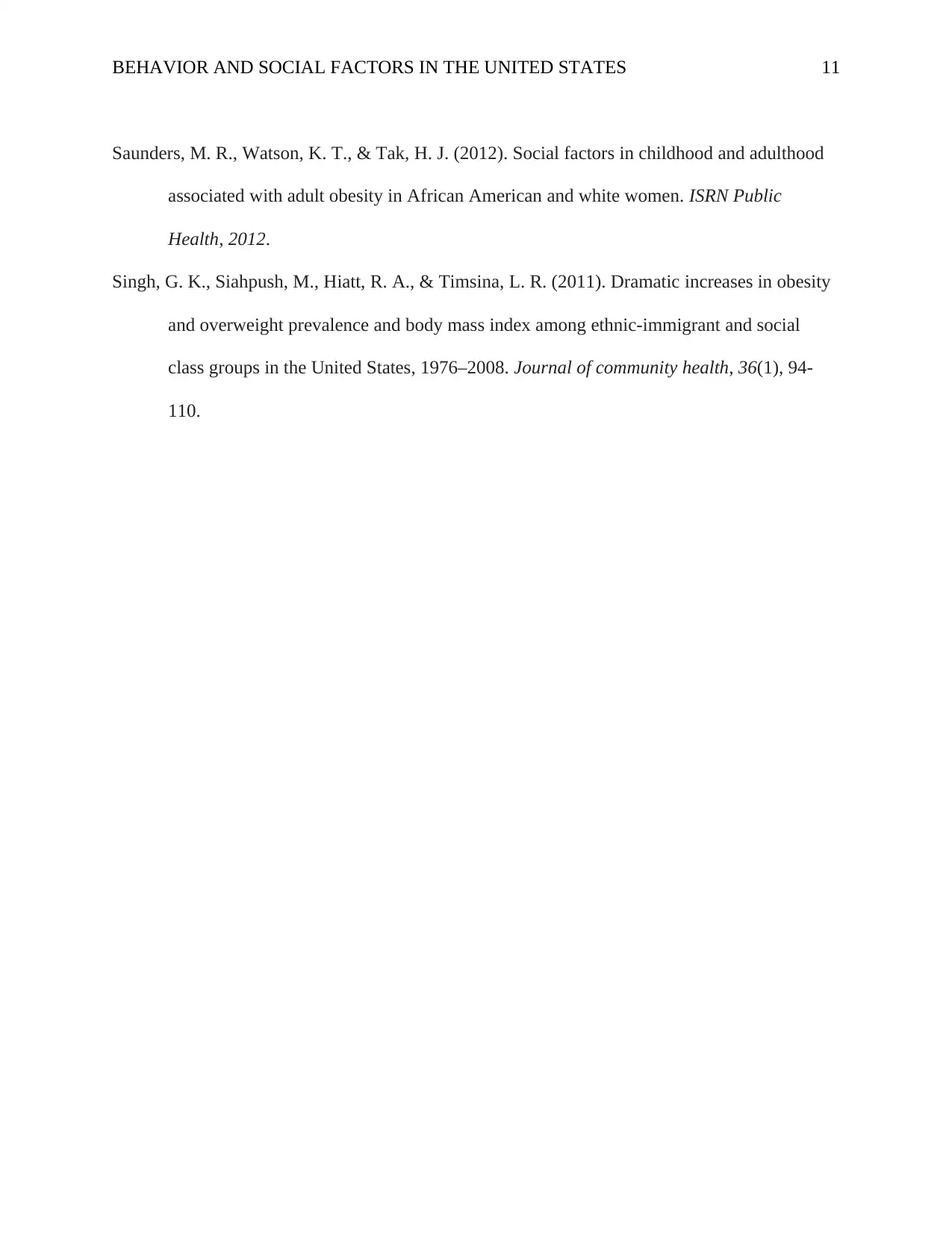
BEHAVIOR AND SOCIAL FACTORS IN THE UNITED STATES 11
Saunders, M. R., Watson, K. T., & Tak, H. J. (2012). Social factors in childhood and adulthood
associated with adult obesity in African American and white women. ISRN Public
Health, 2012.
Singh, G. K., Siahpush, M., Hiatt, R. A., & Timsina, L. R. (2011). Dramatic increases in obesity
and overweight prevalence and body mass index among ethnic-immigrant and social
class groups in the United States, 1976–2008. Journal of community health, 36(1), 94-
110.
Saunders, M. R., Watson, K. T., & Tak, H. J. (2012). Social factors in childhood and adulthood
associated with adult obesity in African American and white women. ISRN Public
Health, 2012.
Singh, G. K., Siahpush, M., Hiatt, R. A., & Timsina, L. R. (2011). Dramatic increases in obesity
and overweight prevalence and body mass index among ethnic-immigrant and social
class groups in the United States, 1976–2008. Journal of community health, 36(1), 94-
110.
1 out of 11
Related Documents
Your All-in-One AI-Powered Toolkit for Academic Success.
+13062052269
info@desklib.com
Available 24*7 on WhatsApp / Email
![[object Object]](/_next/static/media/star-bottom.7253800d.svg)
Unlock your academic potential
Copyright © 2020–2025 A2Z Services. All Rights Reserved. Developed and managed by ZUCOL.





